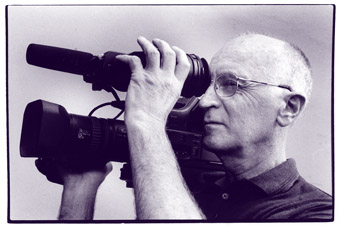Peter Oldham: man with a camera
RealTime

Peter Oldham
photo Heidrun Löhr
Peter Oldham
Everybody in the contemporary performance and dance scenes (and not a few in theatre) in Sydney knows the familiar figure of videomaker Peter Oldham shooting from the shadows in the back row or upfront, snaking through the curliest of performer-audience configurations. Since the early 80s, Peter has recorded most of the significant performance works around a variety of venues, theatres, galleries and outdoor sites. With a small grant from the NSW Ministry for the Arts, Open City (publishers of RealTime) is currently facilitating the establishment of The Oldham Archive with the Centre for Performance Studies at Sydney University. Not only does Peter Oldham know the territory and like the work, he knows how valuable a professionally produced video can be for artists and how much they can afford to pay for it. For a while now Peter has been noticeably off the case, a consequence of increased costs for equipment hire and artists’ shrinking access to adequate funds.
The Australia Council’s Audience and Market Development and Arts Development divisions have jointly funded Performing Lines to organise the provision of high quality promotional video material for independent performing artists and groups.
Performing Lines has established and will oversee a small video production facility, based in Sydney, but available to artists and companies nationally. This facility will co-ordinate the services of Peter Oldham.
The video production unit consists of a Sony DSR-250P 3 chip digital camera along with a Final Cut Pro Edit Suite operated on an Apple Macintosh G4-500 Dual Processor Computer. Peter will have the use of this equipment and, for a reasonable fee, offer his services to artists and companies to coincide with the first production and/or tour of their new works
Says Performing Lines’ Director Wendy Blacklock, “Most independent artists allocate small amounts of their budget towards the production of some print and video material. Some establish websites and produce CD-ROMs. However, too often, their efforts are undermined by the fact that they did not produce good enough material in the first instance—particularly videoed footage of their productions. With an increased emphasis on marketing Australian arts internationally and the need for an historical record of the innovative work being produced, this service will assist in redressing this imbalance.”
What this offers to the performance community is freedom from the costs of hiring camera and editing equipment. Because they only have to pay for labour, this represents a key reduction in costs and already, according to Peter, artists are making good use of the service. RT
RealTime issue #41 Feb-March 2001 pg. 12






